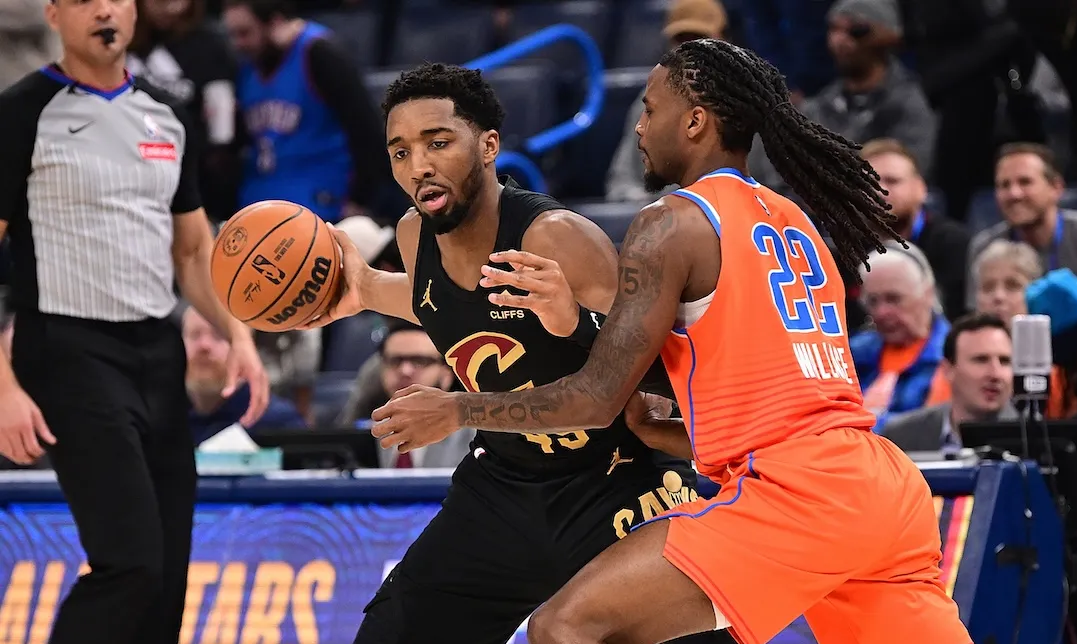Halfway through the first quarter of Oklahoma City’s blowout revenge win over the Cavaliers on Thursday, Max Strus hit a corner three to give Cleveland a two-point lead. That bucket would turn out to be quite a lonely one. The Thunder immediately ripped off a 30-2 run, a rugged sequence that highlighted the qualities that make them so great on both sides of the ball.
Consider that Oklahoma City lost the first game between these teams in large part because of the opponent’s dominant duo of bigs, came into this one even smaller thanks to Isaiah Hartenstein’s injury, and yet ran away with the win. The Thunder’s lack of size, rather than dooming them, forced them to play compounded Thunderball and in the process showed what makes them special. Watch them work, and you’ll see a coherent philosophy unifying the ways they operate on both offense and defense, one built around the drive. It is a philosophy of pressure.
Oklahoma City’s halfcourt offense is not super complicated, which is largely to Shai Gilgeous-Alexander’s credit. In the Thunder’s best lineups, everything begins with him creating an advantage, then flowcharting from there. Oftentimes the best decision he can make is to cook his man and get to either the rack or a comfy spot in the midrange; as much as people roll their eyes at his foul-baiting game, Gilgeous-Alexander is posting the lowest free-throw rate of his career as a high-usage player and is killing opponents in the midrange. That’s all results stuff—the process-oriented point here is that Gilgeous-Alexander gets all those ethical buckets (16 of them on Thursday) by attacking his defender and breaking them down. From there, a defense has to either let him flambé its perimeter guys or send help, which means surrendering open threes or driving lanes to Oklahoma City’s complementary players—a death sentence given how great Isaiah Joe and Lu Dort are at the former, and how great Jalen Williams is at exploiting the latter.
There is this notion that every team plays the same, which is true only to the extent that every modern offense seeks to capitalize on the same sorts of advantages. The Oklahoma City difference is in how the Thunder create those advantages: through driving. Only Memphis drives more often—the Grizzlies’ offense is super wacky—and no team scores more frequently off drives. Compared to less direct forms of advantage creation, the drive makes the threat immediate, not to mention less turnover-prone. Because Gilgeous-Alexander is such a craftsman with the ball and because Jalen Williams is such a smooth athlete around the rim, either of them getting into the paint at the start of a possession is a five-alarm fire; by comparison, Minnesota’s Anthony Edwards getting a switch onto a big with seven seconds remaining on the shot clock is more of a simple bummer.
The best players in the NBA will usually necessarily be the best drivers and one-on-one technicians. What makes Oklahoma City’s offense special is mostly a matter of degree, not kind. The Thunder’s defense, however, is actually unique. Having the league’s best defense by a significant margin despite the team’s only two functional bigs missing a ton of time with injuries upends every maxim about how defense works. Both Chet Holmgren and Isaiah Hartenstein are tremendous rim protectors, which makes them great at second-order defensive tasks like rotating and contesting shots. Oklahoma City’s defensive approach is about reducing the need for that stuff, by stymying drives and keeping the team defense from coming under pressure in the first place.
The Thunder essentially mirror and duplicate their drive-centric offensive game on the other end of the court, dictating terms with aggressive defense on the ball. They lead the league in steals and turnover percentage, and they don’t utilize a single perimeter player who isn’t comfortable attacking opposing ball-handlers. It is so hard to drive on them. The Cavs spent a good deal of Thursday’s first quarter steering away from Lu Dort, Cason Wallace, and Jalen Williams wherever possible, trying to put Gilgeous-Alexander in as many actions as possible. It’s not that they didn’t know that he tied for the league lead in steals last year; there’s simply no weak point to attack.
The effect is basically creating the benefits of a double-team without compromising back-end rotations. The Thunder doubled down on taking away anything easy anywhere near the rim on Thursday by packing the paint off the ball and accepting that Dean Wade and Isaac Okoro would get to take some threes with a guy sprinting into a semi-doomed closeout—a sensible trade-off for keeping the lane inaccessible.
What makes the fully activated version of the Thunder scary is that Holmgren—one of the two best rim protectors in the league, basically a perfect 3-on-4 rotator—allows them to play even more aggressively on the perimeter. The Thunder will soon be able to afford to turn those Jalen Williams one-on-one plays, where he comfortably holds his own and gets tons of steals, into flash doubles with someone as fearsome as Lu Dort coming over to yank the ball away, knowing that even if the opposing ball-handler somehow escapes that hellacious pressure and knifes inside, they’ll have to navigate a lurking Holmgren.
The question is how well this can work in the playoffs, a place where turnover-focused defenses traditionally have gone to die. You will have a harder time starting up the steals-and-dunks machine against, say, Luka Doncic running 75 isolations than you will against a team that needs to take five passes before taking a shot. Oklahoma City’s offense is already built for the playoffs, and I don’t see any reason to be pessimistic about their defense—especially if the Thunder found the ideal solution (Hartenstein) to their only real problem (grabbing boards)—because the more intensely physical postseason game should allow them to be even more aggressive on the ball without worrying about fouls. In other words, they will be comfortable in a highly pressurized environment because that is where they live.
